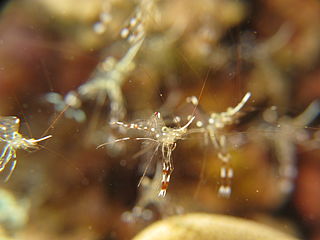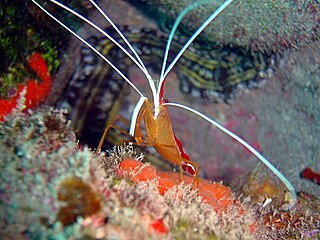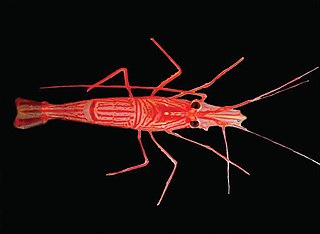
The wrasses are a family, Labridae, of marine fish, many of which are brightly colored. The family is large and diverse, with over 600 species in 81 genera, which are divided into 9 subgroups or tribes. They are typically small, most of them less than 20 cm (7.9 in) long, although the largest, the humphead wrasse, can measure up to 2.5 m (8.2 ft). They are efficient carnivores, feeding on a wide range of small invertebrates. Many smaller wrasses follow the feeding trails of larger fish, picking up invertebrates disturbed by their passing. Juveniles of some representatives of the genera Bodianus, Epibulus, Cirrhilabrus, Oxycheilinus, and Paracheilinus hide among the tentacles of the free-living mushroom corals and Heliofungia actiniformis.

Lysmata amboinensis is an omnivorous shrimp species known by several common names including the Pacific cleaner shrimp. It is considered a cleaner shrimp as eating parasites and dead tissue from fish makes up a large part of its diet. The species is a natural part of the coral reef ecosystem and is widespread across the tropics typically living at depths of 5–40 metres (16–131 ft).

Stenopus hispidus is a shrimp-like decapod crustacean belonging to the infraorder Stenopodidea. Common names include coral banded shrimp and banded cleaner shrimp.

The spotted cleaner shrimp, is a kind of cleaner shrimp common to the Caribbean Sea. These shrimp live among the tentacles of several species of sea anemones. They sway their body and wave their antennae in order to attract fish from which they eat dead tissue, algae and parasites.

A cleaning station is a location where aquatic life congregate to be cleaned by smaller beings. Such stations exist in both freshwater and marine environments, and are used by animals including fish, sea turtles and hippos.

Hippolytidae is a family of cleaner shrimp, also known as broken-back shrimp or anemone shrimp. The term "broken-back shrimp" also applies to the genus Hippolyte in particular and "cleaner shrimp" is sometimes applied exclusively to Lysmata amboinensis.

Lysmata debelius is a species of cleaner shrimp indigenous to the Indo-Pacific. It is popular in the aquarium trade, where it is known as the fire shrimp, blood shrimp or scarlet cleaner shrimp.

Cleaner shrimp is a common name for a number of swimming decapod crustaceans that clean other organisms of parasites. Most are found in the families Hippolytidae and Palaemonidae, though the families Alpheidae, Pandalidae, and Stenopodidae each contain at least one species of cleaner shrimp. The term "cleaner shrimp" is sometimes used more specifically for the family Hippolytidae and the genus Lysmata.

Cleaner fish are fish that show a specialist feeding strategy by providing a service to other species, referred to as clients, by removing dead skin, ectoparasites, and infected tissue from the surface or gill chambers. This example of cleaning symbiosis represents mutualism and cooperation behaviour, an ecological interaction that benefits both parties involved. However, the cleaner fish may consume mucus or tissue, thus creating a form of parasitism called cheating. The client animals are typically fish of a different species, but can also be aquatic reptiles, mammals, or octopuses. A wide variety of fish including wrasse, cichlids, catfish, pipefish, lumpsuckers, and gobies display cleaning behaviors across the globe in fresh, brackish, and marine waters but specifically concentrated in the tropics due to high parasite density. Similar behaviour is found in other groups of animals, such as cleaner shrimps.
Androdioecy is a reproductive system characterized by the coexistence of males and hermaphrodites. Androdioecy is rare in comparison with the other major reproductive systems: dioecy, gynodioecy and hermaphroditism. In animals, androdioecy has been considered a stepping stone in the transition from dioecy to hermaphroditism, and vice versa.

Lysmata wurdemanni, commonly known as the peppermint shrimp, is a species of shrimp.

Lysmata is a genus of shrimp in the infraorder Caridea, the caridean shrimp. The genus belongs to the family Lysmatidae. Lysmata are popular ornamental shrimp in the marine aquarium trade for their bright color patterns, interesting behaviors, and ability to control certain aquarium pests such as sea anemones of the genus Aiptasia. They are known to command high prices on the pet market.

Urocaridella antonbruunii, common names clear cleaner shrimp or red-white cleaner shrimp, is a species of shrimp belonging to the family Palaemonidae. It was described by A. J. Bruce in 1967. It is one of the species that are known as cleaner shrimps.

Cleaning symbiosis is a mutually beneficial association between individuals of two species, where one removes and eats parasites and other materials from the surface of the other. Cleaning symbiosis is well-known among marine fish, where some small species of cleaner fish, notably wrasses but also species in other genera, are specialised to feed almost exclusively by cleaning larger fish and other marine animals. Other cleaning symbioses exist between birds and mammals, and in other groups.

Ancylomenes pedersoni, sometimes known as Pederson's shrimp and Pederson's cleaner shrimp, is a species of cleaner shrimp. It is part of the genus Ancylomenes and was described in 1958 by Fenner A. Chace Jr. as Periclimenes pedersoni. Ancylomenes pedersoni is found in the Caribbean Sea, often associated with a sea anemone, at depths of 1 to 15 metres. They are often found on the reefs off Bermuda.

A shrimp is a crustacean with an elongated body and a primarily swimming mode of locomotion – typically belonging to the Caridea or Dendrobranchiata of the decapod order, although some crustaceans outside of this order are also referred to as "shrimp".

Lysmata grabhami is a species of saltwater shrimp in the family Hippolytidae. It was first described by Gordon in 1935. It occurs in the tropical and subtropical Atlantic Ocean and is a cleaner shrimp, operating a cleaning station to which fish come to have parasites removed.
Lysmata bahia is a species of saltwater shrimp first classified as Lysmata wurdemanni. It is found in shallow waters of the Atlantic Ocean, and can be distinguished by its coloration pattern.

Lysmata pederseni is a species of saltwater shrimp first classified as Lysmata wurdemanni. It is found in shallow waters of the Atlantic Ocean, and can be distinguished by its coloration pattern and its association with tube sponges.

Lysmata ankeri is a species of saltwater shrimp first classified as Lysmata wurdemanni. It is found in shallow waters of the Atlantic Ocean, and can be distinguished by its coloration pattern.

















